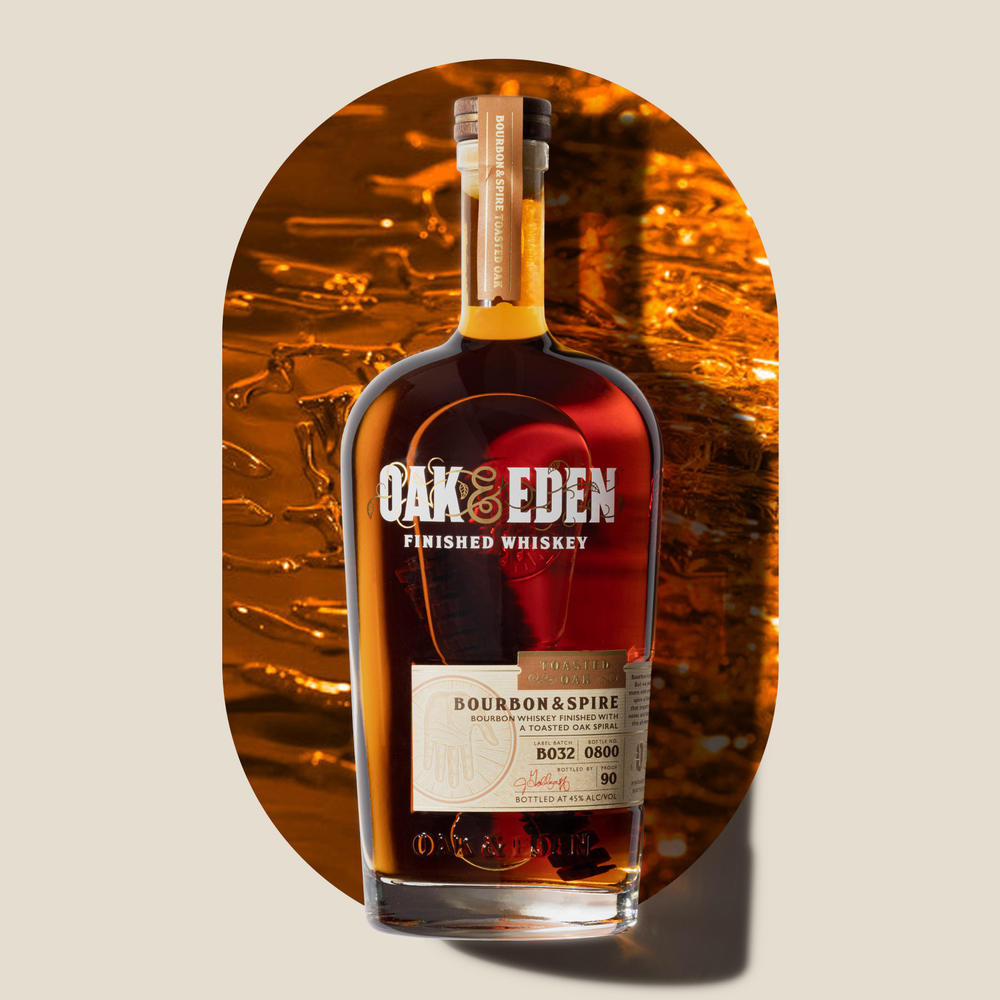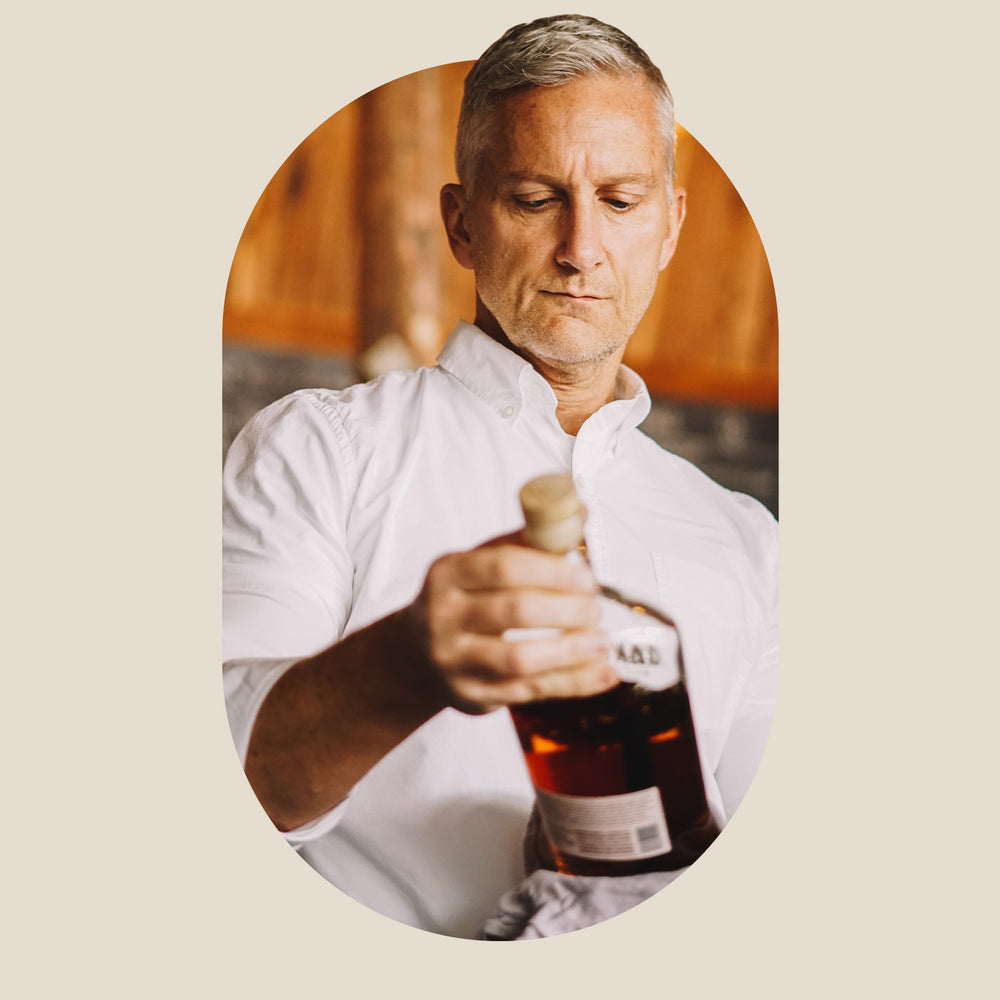
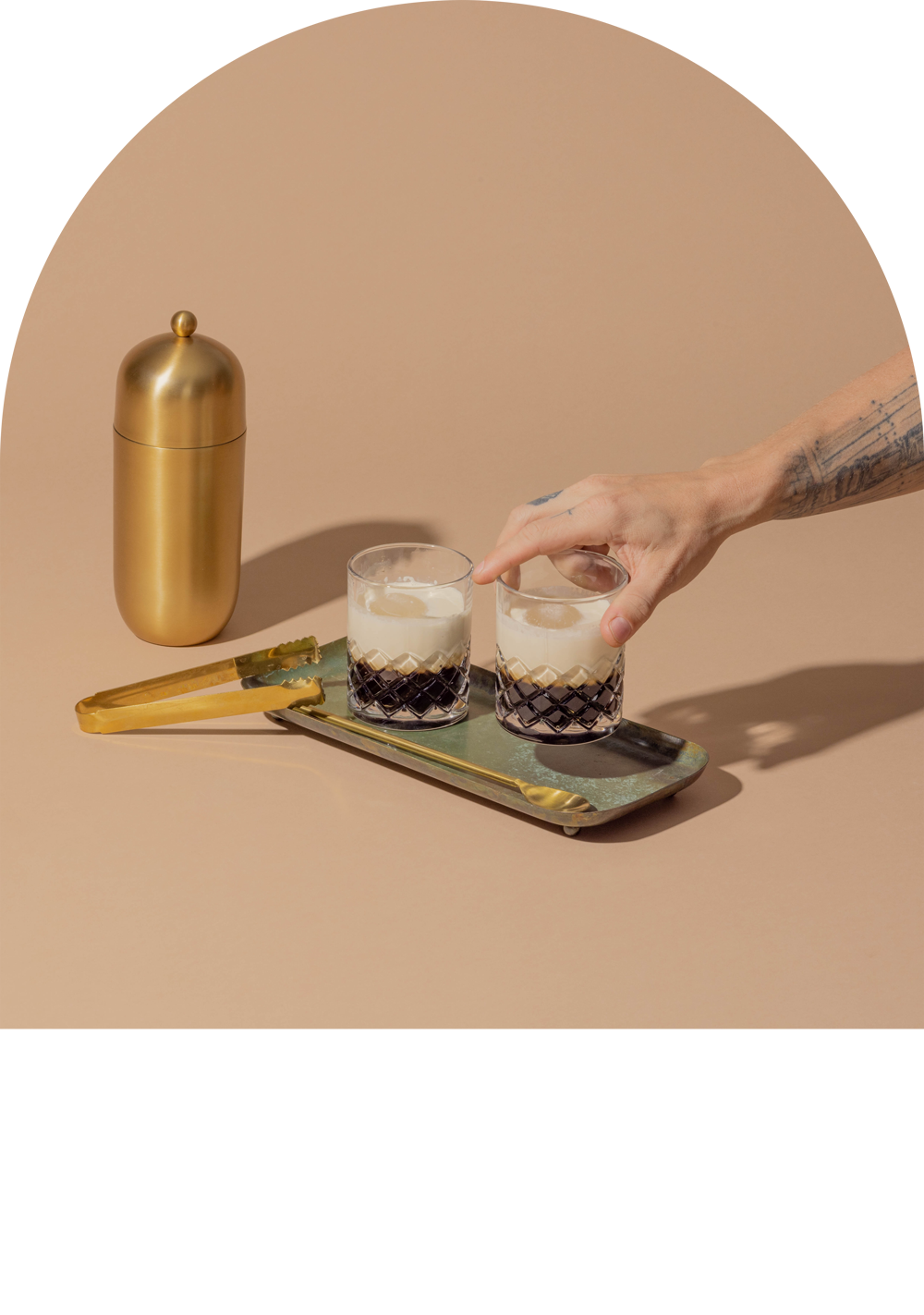
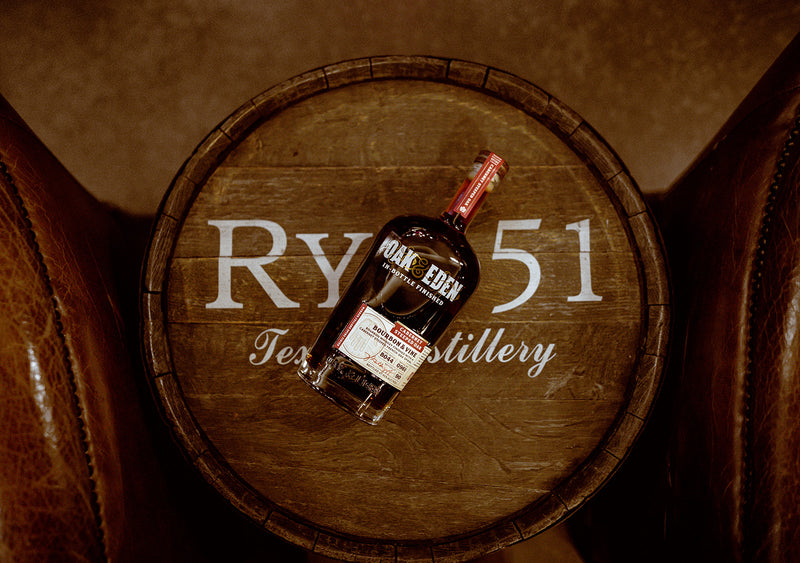
OAK & EDEN X RYE 51 ROADSHOW
Oak & Eden and Rye 51 are hosting a roadshow in the months of October and November! Oak & Eden's award-winning cabernet infused bourbon, Bourbon & Vine, is back for the season and Rye 51's fall collection is the perfect pairing.
Oak & Eden will be making an appearance at all nine Rye 51 locations over the next few weeks. We'll be kicking things off close to home, at Rye 51's Fort Worth location, but below you'll find the details for each event + location. Be sure to click on the RSVP link to let us know you're coming!
Receive complimentary neat pours, craft cocktails, and a chance to win your very own limited edition co-collaborative bottle of whiskey - Rye & Vine.
Forth Worth
Friday + Saturday, October 14-15
3p-6p
RSVP link here
Dallas
Friday + Saturday, October 21-22
3p-6p
RSVP link here
Houston
Friday + Saturday, October 21-22
3p-6p
RSVP link here
Oklahoma City
Friday + Saturday, October 28-29
3p-6p
RSVP link here
Tulsa
Friday + Saturday, October 28-29
3p-6p
RSVP link here
Little Rock
Friday + Saturday, November 4-5
3p-6p
RSVP link here
Nashville
Friday + Saturday, November 11-12
3p-6p
RSVP link here
New Orleans
Friday + Saturday, November 18-19
3p-6p
RSVP link here
Atlanta
Friday + Saturday, November 18-19
3p-6p
RSVP link here
We'll see you there!
Bourbon & Vine is available to shop now, find it here. You can also learn more about Rye 51 here.
READ THE STORY
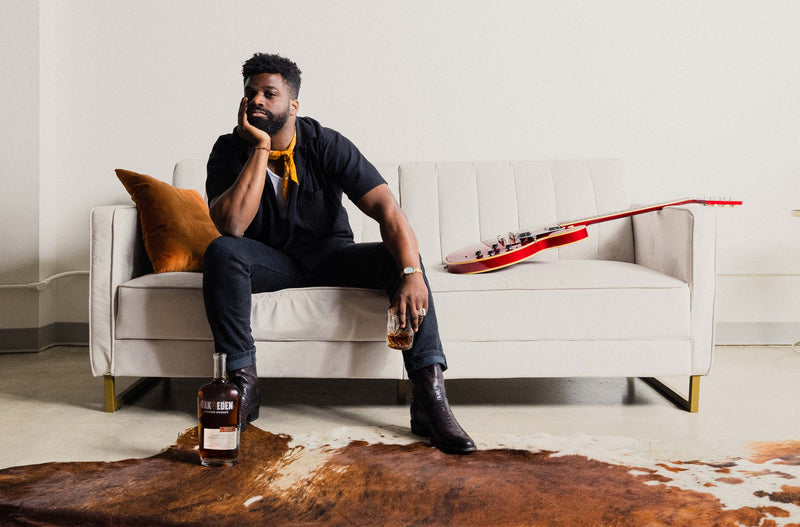
ABRAHAM ALEXANDER X OAK & EDEN WHISKEY
A compilation of heartaches, memories, and faith is what makes Abraham Alexander the man that he is today. Although a young musician, Alexander has gone through life experiences that most will never encounter in a lifetime. Born in Greece to parents of Nigerian descent, Alexander moved to Texas when he was 11. Shortly after the immigration, he tragically lost his mother to a drunk driver, which he describes as the pivot point in his life. Now, he tours with acclaimed artists, such as Leon Bridges and Gary Clark Jr. and has embarked on a solo career that most aspiring musicians could only dream of.
While revered for his musical intellect, his gift for music was actually a recent discovery. Growing up, sports were a universal language for Alexander. In particular, soccer was the sport that truly broke barriers for him. Alexander played Texas Wesleyan, but after an injury permanently sidelined him, he was left wondering what was next. He picked up a guitar and began gigging, recognizing he had a knack for performing. His iconic balance between soul, hip-hop, and blues will make you feel his music, more than you hear it, and others took notice.
In 2015, Alexander bumped into Texas legend, Leon Bridges while Bridges was setting up to record his first album Coming Home. After hearing Alexander humming and noticing his vocal range, Bridges asked Alexander to sing harmony in the album, which charted at number six on the US Billboard 200, and was nominated for Best R&B Album at the 2016 Grammy Awards. From that point moving forward, Alexander’s career has skyrocketed, taking him on tours across the world and growing a cult following, but it’s not his music that draws such attention. Alexander carries a supernatural peace and clarity with him that would calm a storm. He describes his various life trials as the springboard moments that were used for an undefeatable joy that he carries. This joy is unmistakable whether listening to his music, watching him on stage, or enjoying a shrimp basket at Coco Shrimp in Fort Worth.
We collaborated with Abraham to make his custom bottle of bourbon finished with a vanilla infused American Oak spire. The vanilla finish imparts a warm, steady, and nostalgic note to our award winning bourbon. It’s the feeling of coming home after a lifetime of labor and, similar to Abraham’s experience, it’s worth the wait.
READ THE STORY
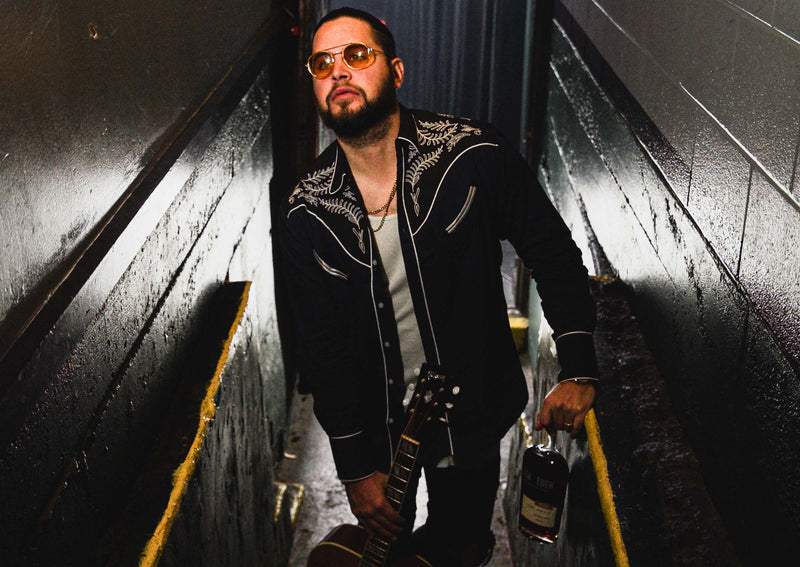
FILMORE X OAK & EDEN WHISKEY
Rising Nashville country music singer-songwriter, Tyler Filmore, better known as ‘Filmore’ is anything but typical when it comes to fashion, sound, and career building. The Nashville musician was born in Wildwood, Missouri, where suburbia touches cornfields. He quickly developed a passionate grassroots following after debuting his single, ‘Slower’ in 2018. Since then, he has taken a “yes” approach to his career, accepting every performance opportunity that came his way, which ultimately led him to performing alongside Sam Hunt, Russell Dickerson, Brett Young, Carrie Underwood, Jon Pardi, and Dan + Shay, as well as performing at venues like Grand Ole Opry, Watershed, CMA Fest, Stagecoach, Country Thunder USA, SXSW, and Faster Horses.
Growing up in Wildwood forced him into a life full of diverse activities, from building forts in the woods to performing in musicals, which influenced his decision to pursue music as his final passion. At the helm of that decision, he made the move to Nashville, where he would find his true, distinctive sound. He recalls moving to Nashville solely because it was the closest place to Missouri that he could afford to drive to and make music. On his relocation journey to Nashville, he performed at every coffee house and venue that would take him, which launched his career into touring, and eventually writing and performing on Broadway.
Alongside a very loyal fanbase, Tyler has built an incredibly loyal team of musicians who have performed together since the very beginning. They have built traditions and routines that make for a very healthy band of brothers. From gathering to pray before shows to, vocal checks, to toasting over a glass of whiskey before shows, the rhythm of their routine has instigated a posture of respect and admiration for one another, making for a one-of-a-kind experience at every performance.
Tyler has always considered himself a coffee connoisseur and appreciates a fine, craft coffee. He has also been a long-time bourbon enthusiast and enjoys a strong bourbon whether at performances or sitting on the porch at his house. We collaborated with Filmore to create a barrel strength bourbon finished with an American Oak spire steeped in cold brew coffee. It is a truly remarkable, bold, rich bourbon that is truly anything but typical.
READ THE STORY
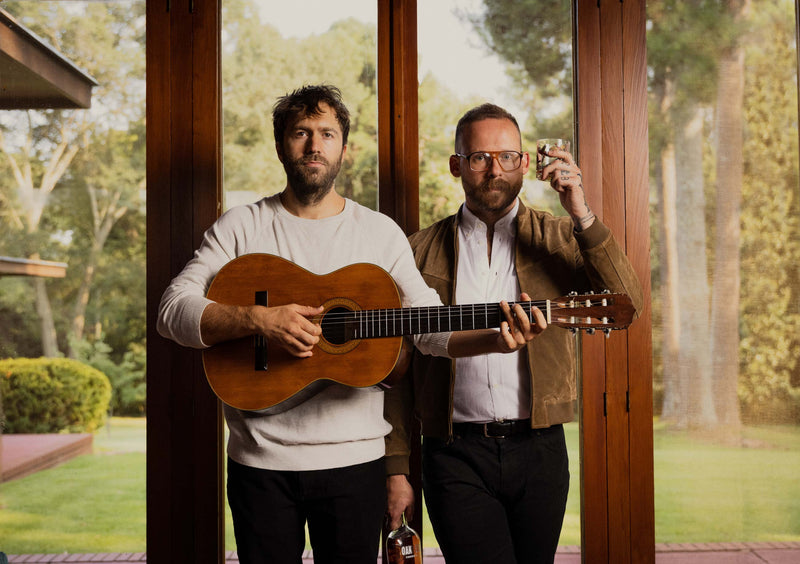
PENNY & SPARROW X OAK & EDEN WHISKEY
Kyle Jahnke and Andy Baxter, or better known as Penny & Sparrow are an iconic Yin and Yang. This musical duo is as playful, authentic, and care-free as it comes. They grew up in different parts of the world, but came together during their time at the University of Texas and began writing and performing shortly after that.
Their music is intimate, personal, magnificent, even cinematic. Deeply vulnerable, and perhaps even emotional, their songs blur the lines between indie-folk and alt-pop. When we first met Andy and Kyle, we immediately picked up on the deep brotherhood and love they have for each other. There is a mutual honor, respect, and support for each other, which compounds the sincerity in their songwriting. “Essentially, we have the same DNA,” shared Baxter, “but different genetics.” Professionally and personally, they share one heartbeat. It’s absolutely mesmerizing.
In 2014, the two quit their day jobs and took on careers full of bookings, tours, and songwriting. After their fourth album, Let a Lover Drown You, they had quite the following and the critics started speaking up. NPR praised the band’s songwriting as a “delicate dance between heartache and resolve,” while The World Café raved that they’ve “steadily built a sound as attentive to detail as Simon & Garfunkel and as open to the present day as Bon Iver.” Rolling Stone hailed their sound as “folk music for Sunday mornings, quiet evenings, and all the fragile moments in between.”
Jahnke is a gifted guitarist with a keen ear for melodies, whereas Baxter is a talented lyricist with a haunting voice and can steer an unmistakable falsetto harmony into any tune. Baxter’s mind swirls around words, books, and stories that form within. Jahnke, on the other hand, is unapologetically more simple. “It’s coffee, the excitement to drink it, and quality sleep for me,” Jahnke says. “When you dive into the details and emotional bearings of these traits, they’re quite similar, just articulated with a twist.”
We partnered with Penny & Sparrow in the Anthro Series to create a bottle of cask strength bourbon finished with a charred American Oak spire. This composition of ingredients is a perfect go-to when it comes to writing and performing. And on that note, we suggest that you listen to their newest single, Adeline, a song crafted out of pieces from years spent learning, hoping, and dreaming, all distilled into one love song.
READ THE STORY
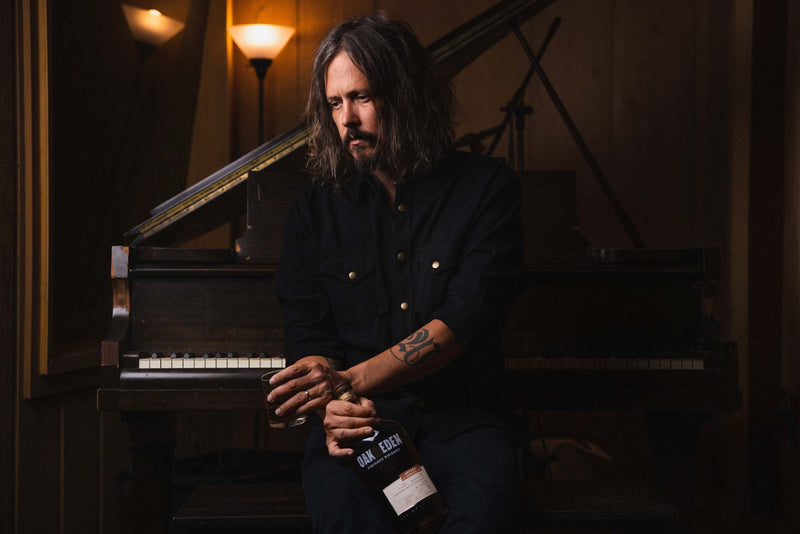
JOHN PAUL WHITE X OAK & EDEN WHISKEY
John Paul White is a classic, idealistic Americana dream. Many would recognize White’s haunting harmonies and undeniable lyricism from his days as one half of the heavily decorated Americana duo, The Civil Wars, but the man behind the melody is as charming as the music he creates.
White was raised on a chicken farm in the tiny town of Loretto, TN. He turned his humble passion for music into a career that would lead him to becoming a four-time Grammy Award winning musician. His interest in music sparked when he and a group of friends performed at their high school talent show, where they would lip sync Back in Black by AC/DC. White was the vocalist for the sheer fact that he was the only one who could recite all of the lyrics. This early introduction to music would plant the seed for a career that would help shape the future of Americana music as we know it.
Throughout the years, he leaned into timeless musical influences such as Merle Haggard and Johnny Cash, who were the inspiration that would help shape his voice. He would go on to cultivate a career throughout the Nashville scene for two decades, first as a singer/songwriter, and then as a publisher. In 2008, he released the album The Long Goodbye. The very next year, he teamed up with Joy Williams to form The Civil Wars. The duo would go on to win four Grammy Awards between 2011 and 2013.
White made home in Florence, Alabama, not too far from Muscle Shoals, where he would continue his solo career, releasing Belulah in 2016 and The Hurting Kind in 2019. While he continues to write and perform, he admits he enjoys being home more often with his wife and children. He currently teaches two classes at the University of North Alabama, and recently started a band with his son. “It makes me feel like a young, passionate musician all over again,” White said.
We partnered with John Paul White to craft his very own custom bottle of whiskey. He selected a barrel strength 4 Grain Bourbon, finished with a charred American Oak spire. It is a bold, smooth, and legendary bourbon, just like the legend himself.
READ THE STORY

JAMESTOWN REVIVAL X OAK & EDEN WHISKEY
Texas native Americana rock duet, Jamestown Revival, made up of Jonathan Clay and Zach Chance, developed a lifelong friendship at an early age, writing music together when they were kids. The two, along with their band, have made quite a splash in the music scene with their haunting, Simon & Garfunkel-esque harmonies and their huge stage presence.
In 2014, they release their first album ‘Utah,’ and were immediately named iTunes’ Singer/Songwriter of the year and have since had over 55 million streams. They have performed at festivals such as Coachella, Stagecoach, Lollapalooza, Farm Aid 2019, Willie Nelson's Outlaw Music Festival, Austin City Limits and Bottlerock, among others. They’ve performed on Conan, had music featured on NBC’s hit show, ‘This is Us,’ as well as a national Dodge Ram commercial. This duo has earned the love of thousands, and we figured it was high time to create a whiskey together.
In 2020, we released ‘Round Prairie Rye’, a signature exclusive collaboration with Jamestown Revival. The level of demand of Round Prairie Rye led us to develop a reprise with Jamestown Revival under Oak & Eden’s Anthro Series.
The name pays homage to Round Prairie Road, which leads to Jonathan’s family ranch near Houston, TX, where Zach and Jonathan grew up playing and writing music. On their 2019 album ‘San Isabel,’ they wrote a song called ‘Round Prairie Road,’ which is about the ranch and how over the years, oil companies have moved in to exploit mineral rights, fences began going up around them, and their little piece of paradise began to lose much of its holiness. The song is passionate, raw, and soul shaking, which inspired us to name the collaborative barrel proof rye blend release, ‘Round Prairie Rye’.
Keeping in line with the personality of the band, we realized that we needed to keep this whiskey as pure and unaltered as possible. Being rye drinkers themselves, Jonathan & Zach began with Oak & Eden’s award winning rye whiskey, at 116 proof (58% ABV), making for a robust, yet surprisingly smooth finish. We then finish this barrel strength rye whiskey with a toasted French Oak spire, imparting a rich, creamy finish.
You can your very own bottle of their signature whiskey here.
READ THE STORY
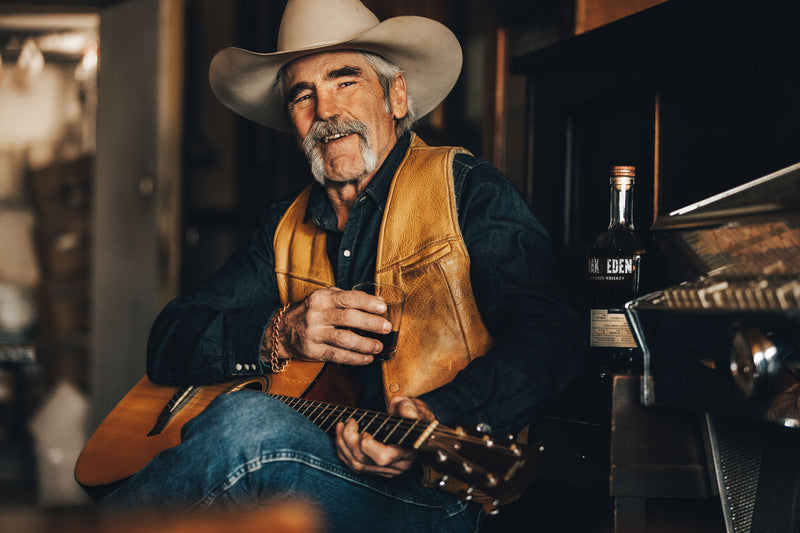
FORRIE J SMITH X OAK & EDEN WHISKEY
It all started when six-year old Forrie J Smith fell off of his horse in front of his mother and immediately told her he wanted to be a stuntman. Forrie is a seasoned cowboy and legacy Hollywood stuntman, but is most known for his role as Lloyd Pierce on Paramount Network’s hit TV show, Yellowstone. Luckily for him, growing up in Helena, Montana was the ideal scenery for him to learn the ropes of the rodeo and master his horsemanship. He was introduced to the rodeo by his father and grandfather and caught rodeo fever early on. At eight years old and on his second pair of chaps, Forrie began competing in rodeos.
After 52 years in the rodeo, Forrie stopped competing. He describes this as a time that his “mind was writing checks that his body couldn’t cash”. After his rodeo life came to an expiration, he pursued a career as a stuntman in Hollywood where he would spend the next 25 years working on sets for films like Rambo III, Desperado, Tombstone and Hell or High Water. Forrie credits much of his rodeo experience to his success as a stuntman, namely the thought disciplines that come with the territory of competing with such intensity.
His stuntman career would ultimately lead him to landing a spot as a series regular on Paramount Network’s hit TV show, Yellowstone. After appearing as a recurring character for the first two seasons, he was brought on as a full-time character in Yellowstone season three. Forrie compares rodeo competitions to filming, describing the similarities of riding an adrenaline rush until you’re finished, completely diminishing any nerves that may have creeped in initially.
As far back as he can remember, Forrie recalls enjoying a bold cup of cowboy coffee every morning before jumping on his horse, which made it fitting to create his very own cowboy coffee-infused bourbon. We collaborated with Forrie to create a barrel strength bourbon finished with an American Oak spire steeped in cold brew coffee. It is a remarkable, bold, rich bourbon that is truly one-of-a-kind.
READ THE STORY
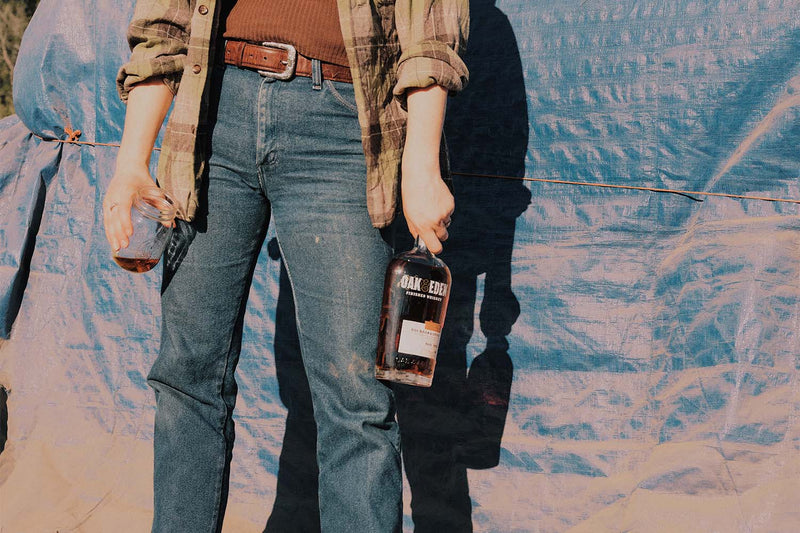
WHISKEY AGING BARREL: WHAT TO KNOW
There are many elements that go into crafting a delicious whiskey.
Every great whiskey starts with a unique mash bill: the grains that are fermented to start the whiskey-making process by turning sugars into alcohol. From wheat to corn, barley, and malt, each whiskey has its own specific blend and grains sourced from unique locations granting their flavors to the blend.
Then, there are the fermentation and distillation processes, both of which create and increase the alcohol content of the liquor. A distiller's skill is showcased here in their ability to create a smooth and clean product from the distillation of alcohol. Aging spirits is an art form, whether it’s tequila, Irish whiskey, or bourbon coming out of the distillery.
Of course, there is still much left to be added to the whiskey. Specifically, there’s one final step that practically every single whiskey goes through: aging. Not only is the age of a whiskey important, but how whiskey is aged impacts the quality, flavor, and depth that a bottle achieves.
The aging process is a complicated part of whiskey-making that is absolutely critical for a rich and complex spirit. Here’s a brief guide to help you understand everything that you need to know about the whiskey aging process and how it impacts your drink.
What Does Barrel Aging Do To Whiskey?
Let’s start by tackling what is probably your biggest question: what aging actually does to a whiskey. While there are many facets of a whiskey that impact its flavor, by far the most important one is the aging process. This starts with American White Oak wood staves, which help to give the whiskey its distinct bitter flavor.
When a whiskey reaches maturity in American oak aging barrels, something truly magical takes place. As the whiskey sits in the barrels through the seasons, the temperature and humidity of the storage room will change, which causes the wood to expand and contract. This causes the wood to almost breathe the liquid as the surface area broadens. As the whiskey is breathed back out, some of the wood sugars, tannins, and vanillin compounds stay in the liquid, adding flavor and color.
The longer a whiskey is aged, the more flavors it can absorb from the wooden barrels it is placed in. The aging process is also responsible for all of the color that you get from a high-quality whiskey. When whiskey enters the barrel, it’s clear like any other neutral grain spirit. Through this aging process, the whiskey takes on the dark colors of the wood. The longer a whiskey is aged, the darker the color will be.
It is critical that whiskey be aged in wood, not metal. Metal does not impart flavor characteristics when you age alcohol in it. Many cheap wines are aged (briefly) in metal casks to keep them fruity and bright without dark woody flavors, but that’s not the norm for whiskey. Aging in wood adds flavor and depth, while aging in metal does not.
How Does Aging Work?
The heart of the aging process comes from the porousness of wood and temperature fluctuations.
When whiskey was first distilled and aged, there were no temperature-controlled aging rooms where they could control the climate for the aging of liquor and alcohol. Because of this, the temperature would invariably change from summer to winter and back year after year, causing the wood to expand and contract over time.
As the wood expands, it becomes more porous and allows the whiskey to enter the wood, where it mixes with the natural botanicals and elements of the wood. These botanicals and elements add flavor and color to the whiskey before it’s dispensed from a spigot or other dispenser.
During the cooler months when the wood contracts, the whiskey is pushed out of the wood along with some of the botanicals and colors, creating a darker, more flavorful product.
What Is Angel’s Share?
If you’re familiar with the whiskey-making process, then you may have heard of the inside term “angel’s share.” The angel’s share is a part of the whiskey-making process which has been acknowledged by whiskey makers since the drink’s earliest days.
As whiskey ages, it naturally loses some of its volume to evaporation. This means that the air in a room with whiskey barrels aging is more alcoholic than normal, giving the air a very nice smell. This does, however, mean that whiskey is lost over time due to oxidation.
Monks were among the first people to have written records of making and drinking whiskey. They called the portion of whiskey lost in aging the “angel’s share,” as it floated up to heaven as an offering in their logic. However, this whiskey was probably closer to moonshine than the whiskey of today.
The longer a whiskey is aged, the more is lost to the angel’s share. This is part of the reason why whiskey that is aged longer is more expensive — it takes more whiskey in the barrel to get the same amount out at the end.
Are There Requirements for Aging Whiskey?
Now that you know just how important aging is to a whiskey, you may wonder if there are certain requirements, limitations, and restrictions that your own whiskey must follow during its aging process. Yes, but it depends: different types of whiskey have their own specifications for aging requirements.
For instance, Bourbon whiskey has to be made and aged here in the United States, and it must be aged for a minimum of two years in new, charred American White Oak bourbon barrels. This is what gives bourbon its characteristic oaky, vanilla, and caramel nose. If you plan on making your own spirits using a small barrel, you’ll need to meet these standards for it to be considered bourbon.
Other whiskeys can be aged for much, much longer, like many Scotch and Irish whiskeys, which are regularly aged for decades before being bottled in the most expensive bottles. These handcrafted drinks are best enjoyed straight out of a decanter rather than used to create an aged cocktail.
The type of wood, size of the barrel, location where the barrels are stored for the aging process, level of care on the barrel, and previous uses of the barrel all impact the flavors that can be added and imparted to the whiskey in the barrel.
What Does a Whiskey Age Statement Mean?
When you look at a bottle of whiskey (or any bottle of liquor for that matter) and you see that its age advertised on the bottle, you may think that this means the liquid in the bottle is exactly that many years old. Well, this isn’t quite so: the age statement is only the age of the youngest whiskey included in the blend at the time it was bottled.
This means that if you have a fifteen-year aged bottle of whiskey from Scotland, you have a bottle of different whiskeys blended together of which the youngest whiskey was fifteen when it entered the bottle.
What Happens as a Bottle Ages?
Once the whiskey enters a bottle, you might hope that it continues to get better with age and improves over time just as it would in the barrel. However, once most whiskeys enter the bottle, the aging process is over and no additional flavors are added.
This isn’t the case with Oak & Eden Whiskey. Our whiskeys use an innovative new technology that turns the whiskey world on its head: in-bottle finishing. Every single bottle of Oak & Eden whiskey contains one of our Spires.
These Spires are expertly crafted spiral-cut wooden spires which are charred and selected specifically for each blend of our whiskey. These spirals add a finishing touch to our whiskey while it sits in the bottle waiting for you to drink. Each bottle of Oak & Eden gets a spire to add just a bit more depth and complexity that you can taste in every drop.
Takeaways
There are a lot of aspects of a great whiskey, but one of the most important is the aging process. How whiskey is aged is responsible for all of the color in a whiskey and many of the complex flavors as well.
The aging of a whiskey in American White Oak barrels works because of temperature variations over time. This causes the wood of the barrels to expand and contract, allowing whiskey in and out of the wood. This allows the whiskey to grab on to some of the colors and natural botanicals in the wood, which then stay with the liquid when it is pushed back out of the wood in the winter.
Different types of whiskey need to be aged for different lengths of time. For instance, bourbons have to be aged for a minimum of two years in new barrels, while other kinds of whiskey require different types of wood and different age requirements.
The age statement that you see on a bottle of whiskey when you buy it is actually only the age of the youngest barrel of whiskey included in the blend. This means if you have a five-year-old whiskey, it could contain whiskeys older than five years, but not any younger.
Once a whiskey enters the bottle, it is normally no longer able to age and mature. Oak & Eden whiskey uses state-of-the-art in-bottle finishing techniques that we innovated to add depth after bottling. These techniques also make our bottles phenomenal picks for father’s day gifts or groomsman gifts, as well as for toasting at your next special occasion.
Aging whiskey is a crucial step in the process. With this knowledge, you will better be able to enjoy and appreciate a finely aged whiskey.
Sources
Distillation | Organic Chemistry CU Boulder
What Is the Effect of Aging on Liquor? | The Spruce Eats
What Is the Angel's Share? | The Whiskey Wash
READ THE STORY
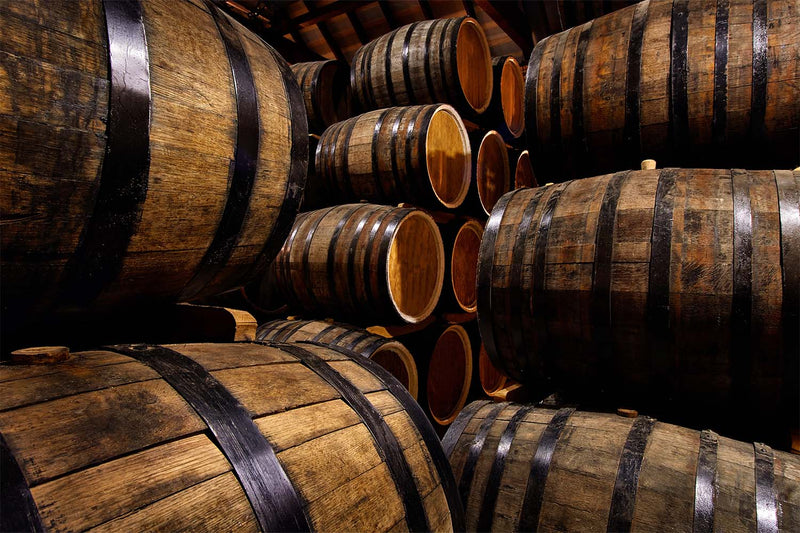
BOURBON AGING BARREL: WHAT YOU NEED TO KNOW
Oak is the key to aging bourbon.
Oak barrels are essential to the bourbon aging process because they impart flavor and color to the spirit as it matures. The type of oak, how long the barrel is charred, and where the barrel is stored all play a role in the final flavor.
A bourbon barrel is charred to create a surface that will interact with the spirit and help impart those flavors we all know and love. There are different types of oak, each lending its own nuance to the process. Let's take a closer look at what goes into making a bourbon barrel and how it affects the taste of one of America's most popular spirits.
What Is Bourbon?
Bourbon is a type of American whiskey that is made from corn and other grains.
Bourbon's main ingredient is corn, and the mash bill must be at least 51% corn to be a true bourbon. Other grains that can be used to make bourbon include rye, wheat, and barley.
Bourbon must be aged in new oak barrels for at least two years. The barrels must be made of American oak that has been charred on the inside. These barrels give bourbon its characteristic amber color and unique flavor.
Bourbon must also be bottled at 40% ABV, or alcohol by volume, in order to be considered authentic. You can find many "cask strength" whiskies available that feature ABV of up to 60% or more. We offer some higher-proof bourbons and whiskies in our Collaborations Series.
What Do Barrels Do for Bourbon?
Beyond serving as a vessel to hold the whiskey while it ages for a minimum of two years, the bourbon barrel serves another important purpose. When the whiskey enters the barrel it is clear, and when it is ready for the bottle, it is a deep, rich amber color, full of flavor and depth.
All of the color and a majority of the flavor in any bottle of whiskey comes from the barrel, with the rest coming from the grains in the mash bill.
So, what does the barrel do for your bourbon? It takes a nearly neutral grain alcohol and turns it into delicious, caramel-colored whiskey.
How Are Bourbon Barrels Made?
The bourbon barrels that any distillery uses have to be brand new barrels, meaning they all start out at the cooperage. At the cooperage, they receive shipments of American Oak. All bourbon must be aged in American oak, which has been cut into staves — the technical term for the planks of wood that make up each barrel.
The barrel heads are then made, and the staves are put together and held in place with metal hoops. This is done so so that the barrels are completely liquid-tight, but not so that they are completely air-tight. That extra airflow is what allows for the flavor to get in.
Next, the barrel is filled with water to soak for several days. After the barrel has soaked, it’s time to char the inside.
Charring is done by setting the barrel on fire and letting it burn for about 30 minutes. Every whiskey and bourbon barrel has to be charred, but the level of char is left up to each distiller. Charring can be a major difference-maker for the flavors of different distilleries' whiskies.
Once the barrel has cooled, it is then filled with bourbon and sealed. The barrel will sit for at least two years and usually for longer — up to decades. During this time, the bourbon will take on the flavors of the wood, creating a unique and delicious taste.
How Does Barrel Aging Work?
When you put a whiskey or bourbon into a barrel, the barrel is liquid-tight but not airtight. This means that the barrel is susceptible to temperature and humidity changes.
Wood is porous, meaning that it has pores that liquid can fill. This is why wood stays wet longer than a metal pole. As the temperature changes through the seasons, the wood that makes up the barrels expands and contracts, affecting the wood's porousness.
This expanding and contracting of the wood pulls in and pushes out the whiskey, and along with the whiskey, botanicals, flavor notes, and coloring agents leave the charred wood and enter the whiskey.
These additions mellow out the harsh flavors of the liquor and impart the rich color and deep vanilla, oak, and caramel flavors that bourbon whiskey is known for.
What Types of Wood Are Used for Whiskey Barrels?
While bourbon has to be made in new, charred American oak barrels, not all types of whiskey are limited in this way.
Across the globe, whiskies are made using all sorts of different kinds of wood, and we even make several whiskies here at Oak & Eden that utilize woods other than American oak for finishing.
The most common types of wood used in whiskey barrels are:
American Oak
American Oak barrels give whiskey a rich, deep flavor with notes of vanilla and caramel. American Oak is the most common type of wood used for bourbon whiskey, as well as other types of whiskey, such as rye.
Rye whiskey tends to have a spicier flavor profile, and the American Oak helps to mellow out those flavors and add depth to the drink.
French Oak
French Oak barrels tend to impart a fruitier flavor to whiskey, with notes of citrus and stone fruits.
French Oak is less common than American Oak in the world of whiskey, but it is sometimes used for a higher-end, premium whiskey. French Oak is more common in the world of Scotch whisky, where it is used to give the drink a more complex flavor.
Japanese Oak
Japanese Oak barrels are a newer addition to the world of whiskey, and as such, not much is known about them yet.
Japanese Oak imparts a very unique flavor to whiskey, with notes of green tea and bamboo. This Oak is very rare, and it is only used for special releases and limited editions.
Sherry Oak
Sherry Oak barrels are most commonly used in the world of Scotch whisky, where they impart a rich, fruity flavor to the drink. Sherry Oak barrels are made from Spanish Oak that has been seasoned with sherry.
Chestnut
Chestnut barrels are not as common as other types of wood barrels, but they can give a whiskey a unique flavor.
Chestnut barrels tend to impart a nutty flavor to the whiskey, with notes of hazelnut and almond. Chestnut is also a very hard wood, so these barrels can last longer than other types.
Chestnut barrels are most commonly used for premium and limited edition whiskeys.
Barrels Mean a Lot to Us
Here at Oak & Eden, we love the wood that we use for our whiskey because our whiskey is built on wood. Every bottle of Oak & Eden whiskey gets one of our expertly-crafted wooden spires.
These spires are made from different kinds of wood, toasted and charred to match each blend of whiskey we offer. The spires help achieve our in-bottle finishing approach to whiskey, which lets us continue to add depth and flavor to our whiskey after bottling.
We’re committed to using only the highest quality oak barrel available on the market today. We utilize both American and French oak from the best suppliers in the world to make wooden spires for our in-bottle finishing technique.
The result? Whiskey that you have to try to believe.
Why Does Bourbon Have To Be Aged for So Long?
Bourbon has to be aged for at least two years, but most bourbons are aged for four years or longer. The aging process is what gives bourbon its distinct flavor and color. The longer a bourbon is aged, the more mellow and smooth it will become.
Bourbon has to be aged for a long time because of the reactions and processes that happen over time. These reactions can’t really start until about eight months of aging have occurred.
In general, whiskey that is aged longer is more expensive — it’s going to taste better since it has had longer to age.
At the end of the day, the speed of the aging process is actually relative; the more flavor you can pull from the barrel to the whiskey in less time, the faster you can age a whiskey. However, speeding up the process has proved difficult for distillers.
The speed of the aging process is determined by the volume of liquid and the surface area of the wood. That means a smaller barrel will age whiskey faster. Of course, that requires more wood for smaller barrels, which eventually cancels out the effectiveness of this technique.
Bourbon Aging Barrel: Takeaways
The barrel that your bourbon is aged in is a major player in the flavor components that get into your whiskey.
Bourbon barrels must be made of American Oak, but other styles of whiskey can use barrels made with one of several types of wood, including American, French, Japanese, or Sherry Oak. The type of Oak used will impart different flavors to the whiskey.
Bourbon must be aged for at least two years, but most are aged for longer. The aging process is what gives bourbon its distinct flavor and color.
While aging bourbon in smaller barrels can be a way to get high-quality flavor faster, this technique is a bit of a paradox. It ages the bourbon faster, but it also gives distillers less capacity in each barrel. Ultimately, it’s up to the distiller to decide how big their barrels will be.
At Oak & Eden, we use carefully aged whiskey in our blends before using our secret element - wooden spires for in-bottle finishing. These wooden spires help unlock additional depth of flavor in all of our whiskies, and each one has its own distinct taste and aroma.
Sources:
What's the Difference Between Bourbon and Whiskey? | Food & Wine
What Is the Effect of Aging on Liquor? | The Spruce Eats
How Fire-Charred Whiskey Barrels are Made | Eater
READ THE STORY
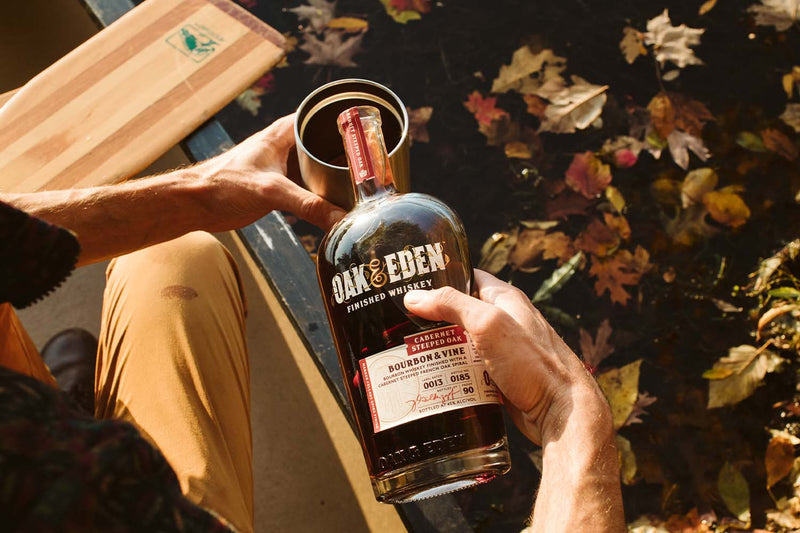
WHAT IS BLENDED WHISKEY?
If there is one thing we all know, it’s that whiskey is delicious. Still, there’s one other thing we all know about whiskey: it can be confusing for newcomers and experts alike.
There’s a lot of terminology in the whiskey world — everything from the malt to the mash bill, the angel's share, and small-batch — it can be a lot to follow. One of the terms that get thrown around a lot is blended whiskey.
What is blended whiskey? Many people have never even heard of it, let alone know what it is. Even the most experienced whiskey-drinker may not be able to answer that question off the top of their head.
That’s why we’re here to help you out and give you a better understanding of what a blended whiskey is and how it compares to the other whiskies you have tried.
What Are the Different Types of Whiskey?
Whiskey is a type of alcoholic beverage made from fermented grain.
There are many different types of whiskey, plus a plethora of sub-types to explore. For Scotch whiskey, as an example, these subtypes include single malt, single grain, blended malt, blended grain, and blended whiskey:
Single malt whiskey is made at one distillery from 100% malted barley and is distilled in pot stills.
Single grain whiskey is made at one distillery from various grains such as wheat, corn, or rye and is distilled in column stills.
Blended malt whiskey is made by blending different single malt whiskies, which can be from the same or different distilleries.
Blended grain whiskey is made by blending different single grain whiskies, which can be from different or the same distillery.
Blended whiskey is made by mixing both single malt and single grain whiskies.
All types of whiskey are aged in barrels for a specific amount of time. This amount changes based on the type of whiskey and the distiller.
The length of time that the whiskey is aged will impact the flavor profile, producing different notes and aromas. Bourbon whiskey, for example, must be aged for a minimum of two years in new charred oak barrels, while Scotch whisky must be aged for a minimum of three years in used oak barrels.
There are dozens of other ways to break down a type of whiskey into its subtypes, but when dealing with Scotch whiskey, this is the preferred method.
What Is Blended Whiskey?
Blended whiskey is a combination of two or more different types of whiskeys. The whiskeys used can be from the same distillery or different distilleries, and they can be made from any grain — but usually corn, rye, wheat, or barley.
These different whiskeys are mixed together in various proportions to create a unique flavor profile that is typically lighter and smoother than other types of whiskey. Because blended whiskey is a mixture of several drinks, there are endless possibilities for variety and flavor.
Why Blend Whiskey?
Let’s say you have the option to go for a single malt or single grain whiskey that you know is one recipe of grains or malts in the bottle. If so, why would you bother with blended whiskey instead?
As it turns out, there are a few reasons, but it starts with accepting the fact that single malt or single grain whiskies are not naturally better than blended whiskies.
This is because phenomenal whiskey is about the flavors and aromas that a distiller can create during fermentation and distillation. That’s the case for single grain, single malt, and blended whiskies alike. Combining the flavors of several different whiskies — even whiskies made in different distilleries — can even give you more flavor in one bottle.
Another reason you may want to reach towards a blended whiskey is that they are typically cheaper than single malt or grain whiskey. This gives whiskey drinkers a more affordable option in the world of Scotch, where single malts and blends are most common.
A Brief History of Blended Whiskey
Blended whiskey has a long and storied history, dating back to the 19th century.
Once upon a time, blended whiskey glass was expensive. So, when your whiskey bottle ran dry, you simply took it to your grocer, who would fill it directly from a cask.
When these casks began to run low, many grocers started putting in whatever whiskey they could get to keep the supply going — inadvertently creating blended whiskey.
The first intentional blended whiskey was created by a Scottish doctor named Johnnie Walker, who blended together different single malt Scotch whiskies to create a smoother, more consistent product.
The technique proved popular, and soon other distillers began creating their own blends. To this day, Johnnie Walker's Red Label is the most popular blended whiskey sold in the world.
In the early 20th century, blended whiskey became the preferred choice of American drinkers, thanks to its mellower flavor and lower price point. Today, blended whiskey is the most popular type of whiskey in the world, enjoyed by millions of people every day.
Thanks to its rich history and unique flavor profile, blended whiskey is sure to remain a favorite for years to come.
Why Is American Whiskey Not Labeled as Blended or Single Malt?
In most cases, the only whiskey you’ll see labeled “blended” or “single malt” is Scotch. Why?
This is because, in American regulation, the term “single malt” is unregulated. This means distillers can use it without verifying anything. For Scotch whiskey, which is only made using malted barley, single malt means more. However, American blends typically use multiple cereal grains, like corn, wheat, rye, and barley, in the mash bill.
Is Single Malt or Grain Whiskey From One Barrel?
While it might surprise you, single malt or grain whiskey isn’t from one barrel.
The word "single" in this context refers to the fact that the whiskey is made from a single type of grain. For a whiskey to be considered a single malt, all of the grains used in fermentation must be malted barley.
For a single grain whiskey, the only requirement is for the whiskey to be made at one distillery using other grains in addition to malted barley in the mash bill for fermentation.
Most whiskey, both here in the United States and the rest of the world, is made with a blend of grains from countless different barrels. So, why do distillers mix the grains like this?
The most important reason is simple: consistency.
How Does Mixing Barrels Give Whiskey Consistency?
When you drink whiskey, the flavor that you are getting is not primarily from the grains that were used to distill the liquid, but rather from the barrel that your whiskey was aged in. Whiskey would be almost entirely clear if you were to drink it without aging it, and it would be hard to tell it apart from vodka or another neutral-colored spirit.
Something special happens when the whiskey is placed in a wooden barrel for years. As the temperature and humidity in the aging room change with the seasons, the wood expands and contracts.
This pulls whiskey into the wood as it expands and pushes it back out when it contracts. While pushing out the whiskey, the wood leaves behind elements that give you the flavors we know and love.
This is why there are so many rules and regulations around the globe dictating how long whiskey should age. As the whiskey ages, each barrel becomes slightly different. This means that two barrels of whiskey made from the same batch of distillate and stored next to each other during years of aging may end up tasting completely different.
Blending different barrels of whiskey together helps minimize these flavor differences between barrels and bottles. That way, when you buy a certain whiskey, you know what to expect.
Single barrel whiskey is any whiskey that only has the liquid of one barrel in the bottle. These bottles tend to be unique, and they can be more expensive. However, there is always a risk that that one barrel isn't going to be as delicious as the next.
How Expensive Is Blended Whiskey?
As we mentioned earlier, the biggest reason blended whiskey has become so popular is that it is more affordable than single malt whiskey.
You can get a high-quality bottle of blended whiskey in the $50-60 range. On the other hand, most single malts will cost you at least twice that number and can total well into the tens of thousands for the rarest bottles.
However, blended whiskey can get just as expensive. There have been blended whiskies that have sold for well over 100,000!
Blended Whiskey: Takeaways
Whiskey is a delicious alcoholic beverage that can be enjoyed in many different ways. Blended whiskey is any whiskey that is made by combining multiple barrels together to create a more consistent flavor.
This process is different from distilling single malt or grain whiskies, which have to be produced by a single distiller.
Although blended whiskey is typically less expensive than single malt whiskey, it can still be pricey in some cases.
When enjoying whiskey, it is essential to be aware of the different types in order to choose the best one for your tastes and budget.
If you want some fantastic American whiskey to add to your collection, consider any Oak & Eden offerings. Our Finished Whiskeys series features some classic American styles, including bourbon, rye, and even a four-grain that is to die for.
In our Infused Whiskeys series, you will find more adventurous whiskies with added flavor elements like rum, wine, and coffee. Last but not least, in our Collaborations series, you’ll find our bottle collaborations with remarkable ramblers, showcasing the uniqueness of the American spirit.
Whatever you like to drink, we have a whiskey that you’ll love.
Sources:
What's the Difference Between Bourbon and Whiskey? | Food & Wine
What Is the Effect of Aging on Liquor? | The Spruce Eats
Coffey still | Whisky Advocate
READ THE STORY
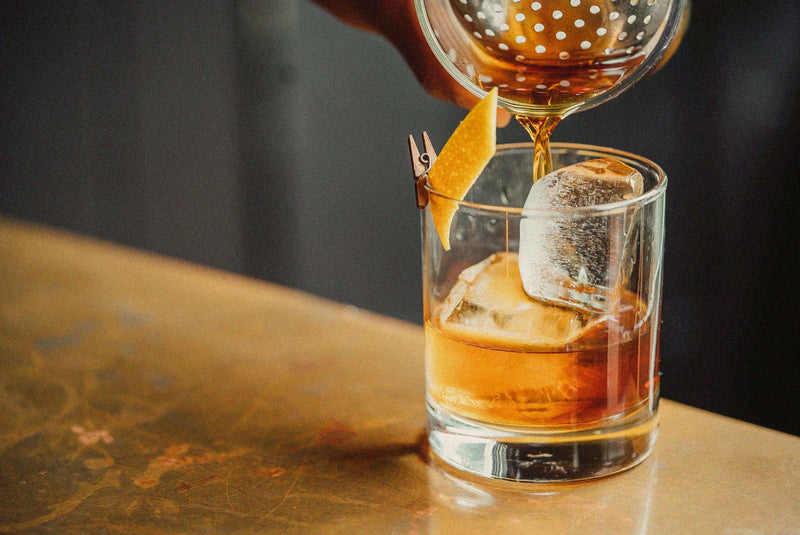
WHAT DOES ON THE ROCKS MEAN?
There are many different ways to enjoy a great whiskey. We have an entire collection of great recipe ideas for delicious whiskey-based cocktails that taste great with our Oak & Eden whiskies. You can check out a few of our favorites like the Sazerac and West of Eden here.
However, drinking whiskey in a cocktail is not your only option. As any whiskey lover will tell you, really great whiskey shines clearest when it is served straight up. But even here, you have the option of ordering your whiskey "on the rocks".
But what does "on the rocks" really mean? Here is a look at what "on the rocks" means when you are ordering at the bar, and how drinking whiskey on the rocks informs the experience. Let's get into it!
What Is Whiskey on the Rocks?
While the phrase "on the rocks" is used frequently at the bar and in popular culture, it means one very simple thing — with ice. The "rocks" are just cubes of ice.
This is as opposed to another phrase that you have probably heard before: "neat". When you order a whiskey "neat", what you are ordering is a glass of whiskey with no ice and no mixers. This makes sense when you think about it; your whiskey is served "neat" without anything else to dirty it up.
The final ordering phrase you should get familiar with so that you can order at the bar like a pro is "straight-up". If you want your drink served "straight-up" you want it chilled, but you don't want any ice in the drink. You might order a martini, for instance, neat.
Here's a fun last one for you: "with a twist" can be added at the end of any drink order to ask for a lemon twist in your drink as a garnish.
Can Cocktails Be Served on the Rocks?
Yes! Any drink that you order at the bar can be ordered on the rocks to ensure that there will be ice in your cup. You can order whiskey, or any other hard liquor, "on the rocks", as well as any cocktail.
Keep in mind, however, that some cocktails are meant to be served with ice and others are not. If you don't want to look like a confused 21-year-old at the bar, make sure you aren't ordering a drink on the rocks that no one would drink on the rocks — like a martini.
Does Ice Change the Way Whiskey Tastes?
By this point you're probably asking yourself if there is a difference between whiskey served neat versus on the rocks, and if one is superior to the other. Well, the answers might surprise you.
Having a whiskey on the rocks versus neat will provide you with a different experience, and help you identify different flavor notes, aromas, and hints that the distiller worked hard to infuse into your whiskey.
This is for two reasons, the first being temperature.
How Temperature Affects the Flavor of Whiskey
We have already written extensively on how temperature affects the flavor and shelf life of whiskey while it is in storage. If you want to read more about how to store your whiskey effectively to preserve its flavor you can check out our articles on the topic here in our Journal.
But here we're going to talk about temperature in relation to whiskey that is poured for drinking. The temperature of the liquor when it touches your tongue absolutely changes and alters the flavors that you are going to get.
The ideal temperature for whiskey to be drunk at is about room temperature, between 60 and 65 degrees Fahrenheit. This is also the ideal long-term storage temperature for whiskey, so usually, you will get the most expressive flavor from whiskey at room temperature.
Serving your whiskey on the rocks is going to chill the liquid down quite significantly, which will give you a subtler, less aggressive flavor. This can be a shame for some connoisseurs who want to get every flavor note from a whiskey, but for people looking to acclimate to the flavors of whiskey, this can be a great way to adjust to the flavors.
But temperature isn't the only way that drinking whiskey on the rocks impacts the flavor, there is also the process of dilution.
How Dilution Affects Whiskey
The other way that serving your whiskey on the rocks impacts the flavor is by dilution. Dilution is making a liquid weaker, or less concentrated, typically by adding water. When you serve your whiskey on the rocks, as the ice in your glass melts, it will combine with the whiskey, giving you a less strong glass of alcohol.
Most people think that the more alcohol in their whiskey, the better. However, there is such a thing as too much alcohol, and it can actually impact the flavor of the whiskey. When whiskey is diluted, the alcohol content is lowered, which can make it smoother and more palatable.
The downside is that dilution can also make the flavor less intense. For some aficionados, this is a good thing, as it allows them to enjoy the subtle flavors of the whiskey. Others prefer a more full-bodied flavor and find that dilution just waters down their experience.
Ultimately, it's up to you to decide whether or not you want dilution in your whiskey. If you're looking for a more mellow flavor, then go for it. If you want something with a little more kick, then you might want to stick with a higher-proof whiskey.
How To Taste Whiskey Properly
If you are ordering your whiskey neat or on the rocks, then you are likely tasting your whiskey, not drinking it, and there is a difference. When you are drinking whiskey, you are trying to get the liquid down. But when you are tasting a whiskey, you are focusing very closely on the entire sensory experience of a particular whiskey (aroma, color, texture, and flavor notes).
In order to taste a whiskey to the fullest, you have to take an organized approach that allows you to identify all the senses a whiskey exposes you to. Here is a brief guide to help you taste your whiskey to the fullest, whether you prefer it on the rocks, straight up, or neat.
Step One: Observe
The first hint you have about a whiskey's flavor profile is going to be the appearance of the whiskey. What color is your whiskey? Is it light or dark? This can give you a clue as to how long it has been aged. The longer it has been aged, the darker it will be.
The longer a whiskey is aged, the more woody flavors you should expect from the whiskey. In a clearer whiskey, you may have more flavor notes from the mash bill present, showing off the flavors of the grains.
Step Two: Sniff
Now you should give your whiskey a sniff and enjoy the aromas that the whiskey is giving off. Unlike when you are tasting wine, you should not swirl the whiskey in your glass before sniffing. This is because the swirling helps to release the flavor compounds in a drink, but also releases the alcohol vapors.
While in a wine, the added aromatics from swirling are helpful and the alcohol vapor is not too overwhelming, because of the higher alcohol content in whiskey, swirling will release an unpleasant amount of alcohol vapor.
Rather than swirling, simply take the glass near to your nose, gently take a deep breath through your nose, and see what aromas you can pick up. Is it woody? Fruity? Spicy? These aromas will give you an idea of the flavor profile of the whiskey.
Step 3: Take a Sip
Take a sip and let it linger on your tongue. Pay attention to the texture and the taste. Is it smooth or harsh? Sweet or smoky? Do you taste caramel? Or maybe vanilla?
Pay attention to everything you taste in your whiskey, and try to make connections with how other foods and drinks taste to identify interesting notes.
Step 4: Dilute Your Whiskey
The final step to a whiskey tasting is an optional one but one that most whiskey tasters choose to make. By purposefully diluting your whiskey with a few drops of water, you may be able to identify notes that were previously hidden from your palate.
If you are tasting at a distillery, oftentimes they will provide a dropper bottle with distilled water for this purpose. However, if you are tasting at home, you may find that putting an ice cube in your drink and letting it melt is the best way to dilute it for a tasting.
By taking the time to really observe your whiskey, you'll be able to appreciate all that goes into making this delicious spirit.
Is Whiskey Supposed To Be Ordered on the Rocks?
There are many ways to enjoy whiskey, and there is no one right way to drink it. Whether you prefer your whiskey neat, on the rocks, or in a cocktail, the important thing is that you enjoy it.
Whiskey can be served neat, which means it is poured into a glass with no ice. This is the best way to experience the flavor of the whiskey, as ice can dilute the taste.
Whiskey can also be served on the rocks, which means it is poured over ice. This is a popular way to drink whiskey, as it helps to mellow out the flavor.
If you want something more festive, you can make a whiskey cocktail. There are many delicious recipes to choose from, so you can find one that suits your taste. Whether you like your whiskey sweet or sour, there is a cocktail that will be perfect for you.
On the Rocks: Takeaway
There is no one right way to drink whiskey. Whether you prefer it neat, on the rocks, or in a cocktail, the important thing is that you enjoy it. Whichever way you choose to drink it, be sure to take the time to appreciate the flavor of the whiskey.
On the rocks simply means served with ice. Your alternatives are served neat (without ice) or straight up (chilled, but still without ice). There is no shame in ordering your whiskey exactly how you like to drink it.
If you're looking for a new whiskey to add to your collection, consider our offerings at Oak & Eden. All of our whiskies use our special in-bottle finishing technique, which helps layer flavors and complexity into the drink while it rests in the bottle.
Give it a try today, and enjoy it neat, straight up, or on the rocks.
Sources
Dilution of whisky – the molecular perspective | Scientific Reports
Should Whiskey Be Chilled or Drunk Straight? (2022 Updated) | Liquor Laboratory
Do You Really Know "What On the Rocks" Means? | Thrillist
READ THE STORY
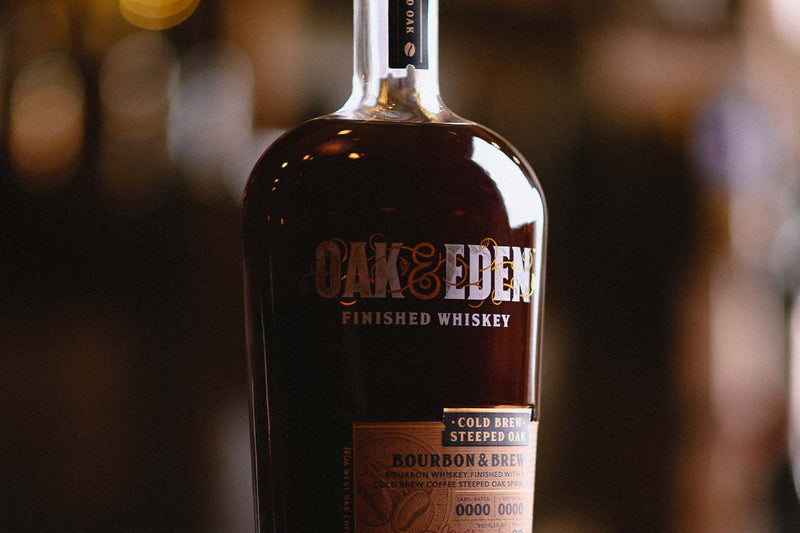
HOW TO STORE WHISKEY: A COMPLETE GUIDE
If you are a whiskey lover, then you know that proper storage is key to enjoying your drink. Whiskey can be expensive, so it's important to make sure that you store it in a way that will preserve its flavor and quality. In this article, we will discuss the different ways to store whiskey and the best practices for each method.
We will also provide tips on how to choose the right whiskey storage for your needs. So whether you are just starting out in the whiskey world or you are an experienced connoisseur, read on for information on how to store whiskey like a pro!
Does Whiskey Go Bad?
Does whiskey ever really go "bad"? Strictly speaking, no — as long as the bottle is unopened and stored properly, your whiskey will be just fine. However, that's not to say that it won't change over time. Whiskey is a complex spirit, and its flavor can be affected by everything from the type of barrel it was aged into to the length of time it spends in the bottle. So if you're wondering whether that dusty old bottle of bourbon is still any good, the answer is probably yes.
But, when you leave a bottle of whiskey that has been open in less than ideal conditions, it can absolutely start to taste wrong. This is for a few reasons, which we will get into just a bit later on.
How Whiskey Goes Bad
Whiskey will never truly spoil — as in you will not get ill because you consumed whiskey that has been stored in poor conditions. However, the flavor notes will start to deteriorate, as well as the color in less than ideal conditions. Here is a look at the two biggest culprits: sunlight and oxygen.
Whiskey and Sunlight
Once opened, a bottle of whiskey exposed to direct sunlight will begin to lose its flavor and lighten in color. This is due to the fact that sunlight breaks down the molecular structure of the liquor, causing it to evaporate and become less potent. As a result, it's important to store your whiskey in a dark place, such as a cabinet or closet, to ensure that it remains flavorful and potent.
Whiskey and Oxygen
Oxidation is the enemy of flavor in whiskey. When oxygen interacts with the whiskey, it begins to break down the molecules that give whiskey its distinct taste and smell. After a few months, oxidation will have a noticeably negative impact on the flavor of your whiskey.
The best way to prevent oxidation is to keep your opened bottles of whiskey sealed properly. You can also pour your half-empty bottles into a smaller decanter or bottle to decrease headspace in the bottle and prevent exposure to oxygen. If you take these steps, you can enjoy your whiskey for months after opening the bottle.
How To Store Open Bottles of Whiskey
Once you open a bottle of whiskey, it's important to take steps to preserve its flavor and freshness.
1. Prevent Exposure to Direct Sunlight
Whiskey should be stored in a dark place, such as a cabinet or closet, to prevent the whiskey from being exposed to direct sunlight. Sunlight can break down the molecular structure of whiskey and cause it to evaporate and become less potent.
To keep whiskey away from sunlight, you can store the whiskey bottle in a box or wrap it in foil or paper. You should also avoid storing whiskey near windows or in rooms with strong sunlight.
If you are going to drink whiskey that has been stored in direct sunlight, you should check the color of the whiskey before drinking it. If the whiskey has lost its color, it may have also lost some of its flavors.
2. Prevent Oxidation
To prevent oxidation, whiskey should be stored in a cool, dry place. The best way to keep whiskey from oxidizing is to keep the bottle sealed. You can also pour your half-empty bottles into a smaller decanter or bottle to decrease headspace in the bottle and prevent exposure to oxygen. If you take these steps, you can enjoy your whiskey for months after opening the bottle.
3. Store Bottles at a Consistent Temperature
Whiskey should be stored at a consistent temperature in order to preserve its flavor and freshness. The ideal storage temperature for whiskey is between 55-60 degrees Fahrenheit.
Storing whiskey at a higher or lower temperature can cause the whiskey to evaporate and become less potent. If you are going to drink whiskey that has been stored at an inconsistent temperature, you should check the color of the whiskey before drinking it. If the whiskey has lost its color, it may have also lost some of its flavors.
You can store your whiskey bottles in a wine fridge or cooler to keep them at a consistent temperature. You should also avoid storing whiskey near heat sources, such as radiators or stoves.
4. Store Bottles in the Upright Position
And finally, you have to store your whiskey bottles in upright positions. If you have a wine collection, then you know those bottles are meant to be stored horizontally. This is to keep the cork moist which keeps the seal.
Whiskey, on the other hand, needs to be stored upright. This is because the alcohol content is so high that if the cork were to be in constant contact with the whiskey, it would begin to deteriorate. So keep those bottles standing upright if it's the last thing that you do.
How To Choose the Right Whiskey Storage Solution for Your Unopened Bottles
Now that we've gone over some of the basics of whiskey storage, let's talk about how to choose the right storage solution for your unopened bottles and collectibles. There are many different types of whiskey storage, but here are a few ideas you can use.
Display Them Behind Your Home Bar
One of the best ways to display your whiskey collection is on a home bar. This way, you can show off your bottles to your guests and impress them with your knowledge of whiskey. Home bars come in many different styles and sizes, so you can find one that fits the aesthetic of your home. If you don't have a lot of space for a home bar, you can also use a liquor cabinet or cart.
Get a Display Case
Another great way to display your whiskey bottles is on shelves or in a glass-fronted cabinet. This way, you can see your collection and admire it, but it is also protected from dust and sunlight. If you choose this option, be sure to arrange the bottles so that they are not touching each other.
This will prevent the labels from being torn or ruined. You should also keep your bottles in their box if they came with one to prevent damage or dust from collecting.
Consider Off-Site Storage
Finally, if you have too many bottles to keep track of and not enough space at home for them all, you should look into off-site storage. Just make sure you are choosing an off-site storage facility that offers temperature-controlled units, as well as units without sunlight.
You will also need to keep checking in on your collection regularly in off-site storage, maintaining a thorough inventory so that if anything goes missing you know right away.
What To Do With Whiskey That Is About To Go Bad
If you've got a bottle of whiskey that's about to go bad, don't worry — there are still plenty of ways to enjoy it. One option is to use it as a cooking ingredient. Whiskey can add a unique flavor to sauces, marinades, and desserts. If you're feeling adventurous, you can even try your hand at making your own whiskey-infused dishes.
Another way to make use of old whiskey is to create homemade cleaning solutions. Mixing whiskey with vinegar or baking soda can produce an effective cleaning agent for everything from countertops to jewelry. And if all else fails, you can always pour your whiskey into an empty bottle and give it away as a quirky gift.
You can also throw a party, where you invite your friends to bring their half-drunk bottles and everyone finishes the alcohol that is going to go bad. Or if you want to try your hand at blending, you can pour all the remaining whiskey drams into one decanter, bottle, or even just a mason jar.
Let the flavors meld for a week or two before tasting and adjusting your blend. Or continue to add the drams of bottles you finish for an ever-evolving blend that is purely your own.
So next time your whiskey starts to turn, don't head for the nearest drain — there are still plenty of ways to enjoy it.
How To Store Whiskey: Takeaways
In conclusion, whiskey should be stored in a cool, dark place away from any sources of heat or light. The best way to store whiskey is upright, in a glass-fronted cabinet, or on shelves. If you have whiskey that is about to go bad, there are still plenty of ways to enjoy it, such as using it as a cooking ingredient or making homemade cleaning solutions.
If you are looking for some new bottles to add to your collection, look no further than Oak & Eden. Our whiskies have been shaking up the whiskey world thanks to our special in-bottle finishing technique.
Each bottle of Oak & Eden whiskey contains a specially selected and toasted wooden spire, which adds depth and flavor notes to your Oak & Eden whiskey while it sits in the bottle.
Furthermore, if you have a more adventurous palate for whiskey, consider a bottle from our infused series of whiskey. Our infused whiskies take our spires one step further, infusing them with other flavors like rum, coffee, wine, or vanilla, giving you a whiskey with a unique depth and character that you have to taste to believe.
Whether you like bourbon, rye, or anything in between, we have a bottle that you are going to love right here at Oak & Eden.
Sources
How Best to Store Your Whisky | Whisky Analysis
Whisky oxidation | Alcademics
How to Store Whiskey At Home: Things To Know (2022) | Liquor Laboratory
READ THE STORY
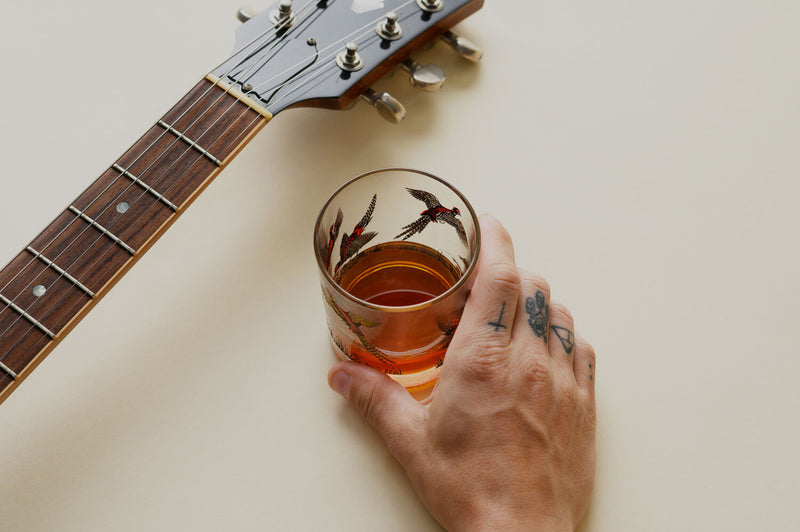
ARTIST CURATION: A JAMESTOWN REVIVAL SOUNDTRACK
Whether you’re feeling strong of heart, bold in your belief, tired after a long day of refining your craft, or dreaming of the days to come, we welcome you here.
READ THE STORY

